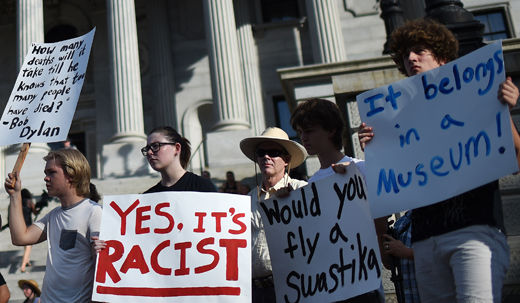
BERLIN – Unlike the swastika, which was banned in Germany and elsewhere after the defeat of fascism in World War II, the Confederate flag was not banned in the U.S. after the defeat of the Confederacy in the Civil War.
Flags and banners and even logos and gestures have always possessed great potency in world history, sometimes positive, often horrifyingly negative. Long insistence on the seemingly undefeatable Confederate “Stars and Bars” is one nasty example now at the center of attention.
Indeed flags, like the black-red-gold of Germans strivings for a republic, the revolutionary French tricolor, England’s imperial Union Jack, the Stars and Stripes or the LGBT rainbow colors, with all their so very different messages – have lifted hearts or caused despair for centuries, too often accompanied by the always-red color of blood. Symbols on the flags have had the same effect; the Christian cross, the Muslim half-moon, the six-pointed Jewish Magen David and the hammer and sickle are striking examples, bad or good, depending on where you are standing.
Sometimes a motion was enough: fingers touching the body four times to form a cross, a two-fingered V for victory, upheld fists of many Communist fighters – or a defiantly poking middle finger.
Most notorious and most tragic, however, have been the Confederate flag in the U.S. and, in all of Europe and beyond, the fascist outstretched fascist arm salute to Hitler and the related Nazi swastika.
After the defeat of the Confederacy its banner was not forbidden. Those who display it claim that the display is protected by the First Amendment in the Bill of Rights. Attempts to have it not banned but simply dropped from use by southern states and by racists, inside and outside the U.S.A were never successful.
Only now, after photos of the nine-fold killer in the Mother Emanuel Church with his flag became public, some governors and politicians in South Carolina, Alabama and other states finally find it necessary to drop it from official use – and hope the matter ends there.
As for the Nazi symbols, more than 50 million deaths caused by the Hitler-led killers demanded a more stringent reaction; the Hitler salute and the swastika were prohibited after 1945 in Germany and Austria, at first by the occupying powers, later by government law.
They also became criminal offenses in the Czech Republic and Slovakia and the salute is illegal in Switzerland and Sweden “if used for propagating Nazi ideology.”
In Germany any form of Nazi salute and any display of the swastika can be punished with up to three years in prison. Symbols like that of Hitler’s special SS killer troops, a pair of Nordic runes like sharply angular S-letters, or the so-called wolf hook, a crossed line with a diagonal prong at either end, each facing a different direction, are also taboo; so are tricks like extending the arm as in a Hitler salute but with only three fingers. There has been no end of ingenuity in thinking up variants to circumvent such laws. With some judges this has occasionally been successful; usually it has not and often led to some new trick, like numbering the letters of the alphabet; 1 equals A, 8 equals H, thus 18 meant “Adolf Hitler,” 88 stood for “Heil Hitler.” This, too, is now forbidden. Special clothing has often been used by pro-Nazis for identification; not only black or camouflage dress and brutal boots but, for some years, jackets and other clothing of a company called Thor Steinar. Sold in special shops which barely disguised their pro-Nazi views, often “improved” with slogans or logos which could be altered if outlawed, this meant that a Thor Steinar jacket meant the wearer was a pro-Nazi, and often a brutal thug!
Until 2014, in Saxony‘s capital, Dresden, there were nine delegates of the neo-Nazi party, the NPD, in the state legislature. Once all nine appeared in Thor Steinar jackets. They were ordered to remove them or leave, and the clothing was henceforth forbidden there (and in other legislatures).
They are no longer represented in the legislature, but there are still more than enough neo-Nazis, with or without such jackets. They have been most numerous in or near Dresden. And new homes for asylum-seekers burn just as readily as southern churches for African-Americans.
Swastika bans were enacted in both the East German Democratic Republic and the Federal Republic, with one major difference. When the Communist Party of Germany was forbidden in the Federal Republic (the West) in 1956 its symbols were also taboo, but were difficult to outlaw since the hammer and sickle were also the official insignia of the USSR. Diplomatic relations prevented nonsense in this regard.
But five years earlier, in 1951, the FDJ, the Free German Youth, a pro-Communist youth organization, which till then existed in all of Germany, was forbidden in the West. Its rising sun logo with the letters FDJ was also forbidden. Young people were actually arrested for wearing its blue shirt with this logo on its sleeve.
A new problem arose with the annexation – called “unification” – of the GDR. The FDJ had been disbanded but one small left-wing group refused to recognize the demise of either the GDR or the FDJ and wore the blue shirt with logo at demonstrations. Since it had never been forbidden in the East it could not be considered legally taboo there – or could it? Must a person change his shirt on the subway train crossing from East to West Berlin? The lawyers are still arguing.
This was part of unceasing media and classroom attempts to equate Nazi Germany with the GDR, denouncing every last detail and every achievement of the GDR and thus hinder any hopes of a socialist future, especially among the younger generation. This policy of deception has often proved very successful; it is closely allied with pressures and propaganda aimed at a left-wing Greece or at Venezuela, Ecuador, Bolivia and, ever since 1959, at Cuba.
While slogans, flags and other signals, good or bad, often have such importance that they cannot be ignored, the Confederate rag in Columbia, South Carolina, simply reflects all that lies behind it.
The super-wealthy too often succeed in embroidering their “proud heritage,” fooling white working people into believing that their future lies with their white rulers rather than with an even poorer group at the bottom of the heap, and which, if they can keep it there, lets them believe they are somehow “up there with those on top”. This deception and fears, since America was born, of losing a presumed advantage, have always made progress difficult or impossible.
This, of course, is what is behind “Stars and Bars,” “Dixie”-incantations, Calhoun Streets and Robert E. Lee statues – and the former lynchings and present-day mass incarceration, police bullying and murder of African Americans.
In Germany, while those trying to out-trick bans on swastikas and Hitler salutes go marching through the streets in nearly every city, and are of great potential danger, an even greater menace, far broader, is a deception similar to that in the U.S.
There are relatively few Jews now, but far more people of Muslim faith. Now, due to terrible wars caused by the very same people who want to squeeze the entire economy and make more billions, there are hundreds of thousands of refugees of war and hunger searching for asylum, even at great risk in the stormy waters of the Mediterranean.
It is again Dresden where we see most dramatically how the anger of worried, dissatisfied and disoriented people can be misdirected with “Deutschland for the Deutsche” slogans that are no less vicious than slogans against minorities or immigrants in the U.S.
The homes of immigrants seeking asylum in Germany burn just as hot as the churches of African-Americans worshipping in the U.S.
Far in the background one finds the people and the institutions that benefit from the toleration and promotion of racist symbols like the swastika in Germany and the Confederate flag in the U.S.
The individuals involved, with their money stowed away in places like the Cayman Islands or Luxembourg, can be found enjoying time on their yachts, flying their luxurious jets or living in their countless mansions – enjoying and living off the profits of the weapons and other industries that are of little benefit to anyone other than themselves.
For the overwhelming majority of the human race, however, there really is no benefit to be gained from provocative and racist flags and slogans.
Photo: Protesters stand on the South Carolina Statehouse steps during a rally to take down the Confederate flag, June 20, in Columbia, S.C. Rep. Doug Brannon, R-Landrum, said it’s past time for the Confederate flag to be removed from South Carolina’s Statehouse grounds after nine people were killed at the Emanuel A.M.E. Church shooting. (AP Photo/Rainier Ehrhardt)










